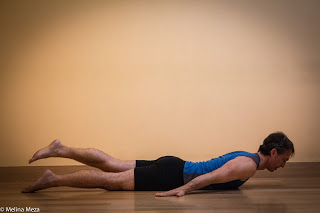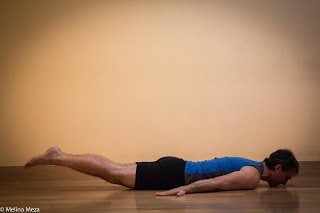by Baxter

Locust
pose is a simple backbend that strengthens the entire back of your
body, from the nape of your neck to the backs of your heels. It’s
helpful for a wide range of problems, including lower back pain,
postural problems, and weakness anywhere along your back body, including
your hips and hamstrings. And because the backbend is shallow and
doesn’t put pressure on your wrists, it is accessible to almost
everyone.
Baxter prescribes this pose for:
- lower back pain (it strengthens the muscles along the sides of your lower back)
- hamstring injuries
- arthritis of the knees (it strengthens the leg muscles)
- postural problems (such as excessive rounding and head-forward syndrome)
- arm strength (in the versions where you lift your arms)
- depression (for mild energizing when your energy is low)
- general weakness
Timing:
For all versions, stay in the pose for 4-6 breaths, breathing
comfortably. Then release and rest for a few breaths before repeating a
second time. Gradually over time work your way up to 12-16 breaths in
the pose. You can also practice this pose dynamically, coming up into
the backbend on your inhalation and releasing on your exhalation.
Cautions:
Lifting too high or too quickly as you come into the pose can trigger a
cramp in the soles of your feet, hamstrings, or lower back. If this
happens, try reducing the height and/or come up more slowly. People with
back pain should start with version 3 (one leg), and as you get
stronger, gradually progress to the classic version. If you experience
back pain in the pose, consult with your teacher about your alignment
before trying it again on your own.
1. Classic Locust Pose

To
come into the pose, start in a prone position with your arms by your
sides and your forehead on the floor. Create a sense of length from your
hips into both feet and from your tailbone up to the crown of your
head. Then, keeping your pelvis and lower belly on the floor, inhale as
you lift your chest, head, and legs a few inches off the floor and lift
your arms toward parallel with the floor. Keeping your knees straight,
reach your legs back as you reach forward through the crown of your
head.
To
come out of the pose, exhale and release your legs, chest, head, and
arms, returning to the starting position. Turn your head to one side and
rest for a few breaths before repeating.
2. Bolster Under Chest (Legs on the Floor)
(sorry, no photo)
This
version is easier for people who are stiff and weak in the upper chest,
and is also a good option for focusing on chest opening.
Before
coming into pose, position the bolster crosswise at the level of your
mid-breastbone and take your arms behind you alongside your torso. Then,
inhale as you roll your head and chest up into a backbend position,
lift your arms up to parallel to the floor or keep your hands on the
floor, and widen your collarbones side to side. Keep your legs on the
floor, but activate and lengthen them.
To
come out of the pose, exhale and release your chest, head, and arms and
drape them over the bolster. Rest there for a few breaths before
repeating.
3. One Leg at a Time

This
version is helpful for those with back pain or sacrum problems as it
strengthens lower back muscles and can rebalance one-sided sacrum
problems.
After
creating a sense of length in your starting position, keep your hips
evenly aligned on the floor as you inhale and come into the pose. Roll
your head and chest up a few inches and lift your arms up to parallel
with the floor or keep them on the floor, and lift just your right leg
up a few inches while continuing to lengthen both legs toward your
toes.
To
come out of the pose, exhale and release your leg, chest, head, and
arms, returning to the starting position. Rest for a few breaths before
repeating on the left. Turn the head for this rest. Then repeat both
sides once more.
4. Legs Only

Because
your chest, head and arms remain on the ground, this version allows you
to focus your work on strengthening your legs and buttocks. Having your
hands on the floor provides more support, and may help you to get more
lift in the legs.
After
creating a sense of length in your starting position, inhale as you
lift your legs up a few inches while keeping your torso, arms and chin
or forehead on the floor. Pressing your hands into the floor, attempt to
swing the legs an inch or two higher.
To
come out of the pose, exhale and release your legs, returning to the
starting position. Turn your head to one side and rest for a few breaths
before repeating.
Follow Yoga for Healthy Aging on Facebook ° To order Yoga for Healthy Aging: A Guide to Lifelong Well-Being, go to Amazon, Shambhala, Indie Bound or your local bookstore.


This is my go-to asana for keeping me honest: if I don't do it religiously every couple of days (holding for 1 min a la Loren Fishman), I know it will just become that much harder to build the strength up again. It's the most demanding pose I ask of myself and I began doing it pre-emptively for occasional sciatic and sacrum twinges. I clear the decks beforehand: hair out of my face, throat cleared, squared on mat, clock visible peripherally, heart rate calm, breath measured and steady, think long extension and not how high. No rushing, no distractions. Did I mention I do not love this asana? No, no, I do not. But it's a good one.
I really like this pose and do it frequently in my classes.